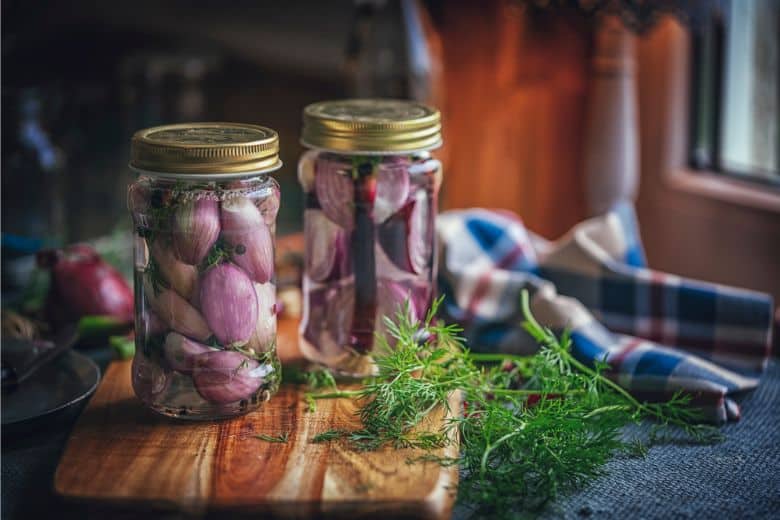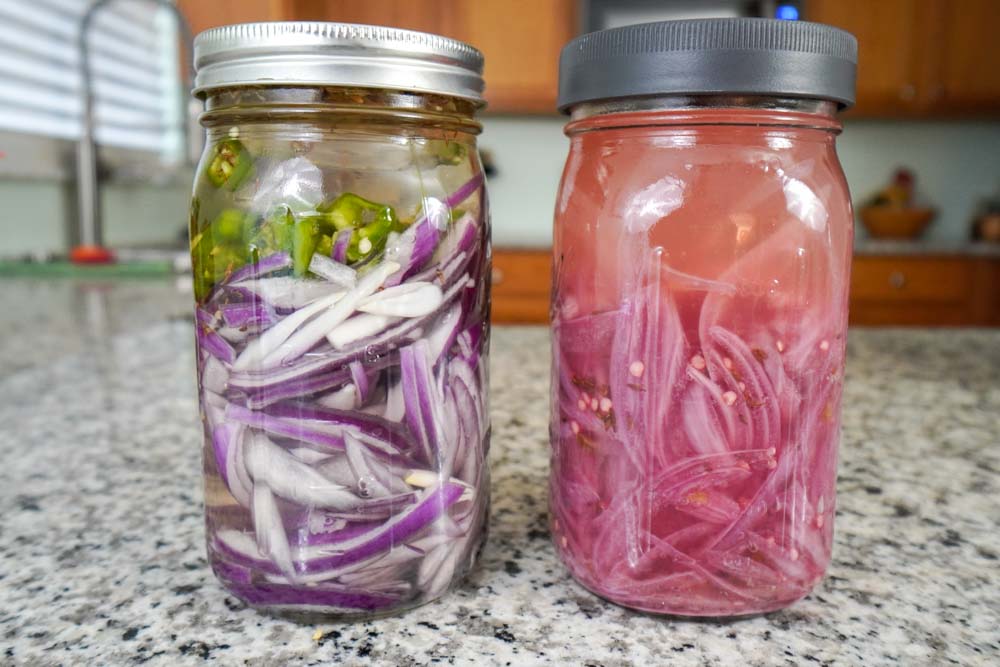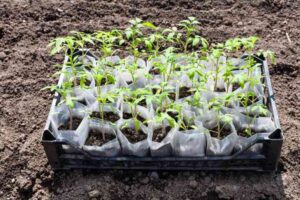
Fermented red onions are a great way to add flavor and nutrition to dishes like tacos, salads, sandwiches, and more.
To ferment red onions, start by peeling and thinly slicing them. Place these slices into a clean, sterilized jar. Next, create a brine solution by mixing 1-3 tablespoons of sea salt (non-iodized) per quart of water, ensuring that the salt is completely dissolved. Pour this brine over the onions, making sure they’re fully submerged. Cover the jar with a tight lid or a fermentation airlock if you have one. Allow the onions to sit at room temperature, away from direct sunlight for about 2 to 3 weeks. Once the onions have reached your desired level of sourness, move the jar to the refrigerator. The fermented onions will keep in the refrigerator for several months.
With a few simple steps, you can ferment red onions in your own kitchen and enjoy the unique flavor of fermented red onions.
What Is Fermentation?
Fermentation is a process used to convert carbohydrates into alcohol or organic acids. This process is also known as “zymology,” and it involves the use of enzymes and microorganisms to break down starches and sugars into alcohol and carbon dioxide.
Fermentation has been used for centuries to create beer, wine, and other alcoholic beverages, as well as breads and other foods. Fermentation also has other applications, such as the production of bioethanol and vinegar.
Therefore, fermentation is used to produce certain vitamins and other compounds in foods, and is responsible for the distinct taste of many fermented products. Fermentation is an amazing process that has been used to create delicious and nutritious foods and beverages for centuries.
Benefits of Fermenting Red Onions
Fermenting red onions provides a variety of health and culinary benefits, thanks to the transformative effects of the fermentation process.
- Enhanced Nutrient Profile: The process of fermentation helps to break down the food into a more digestible form, enhancing the bioavailability of nutrients. This means your body can absorb more vitamins and minerals from fermented foods, such as red onions, compared to their unfermented counterparts.
- Probiotics for Gut Health: Fermented red onions are a source of probiotics, which are beneficial bacteria that support gut health. A healthy gut microbiome has been linked to improved digestion, enhanced immune function, better mental health, and decreased risk of certain chronic diseases.
- Improved Flavor Profile: Fermenting red onions also introduces a depth of flavor that raw onions do not have. The fermentation process gives them a unique, tangy flavor that can add complexity to a wide range of dishes, from salads and sandwiches to main courses.
- Longer Shelf Life: Fermentation is a form of preservation, so fermented onions have a significantly longer shelf life compared to fresh onions. This can help to reduce food waste and allows you to have a flavorful, nutritious ingredient on hand at all times.
- Reduced Sugar Content: The fermentation process reduces the natural sugar content of red onions, making them a healthier option for those watching their sugar intake.
- Ease of Digestion: Fermented foods are often easier to digest than their raw counterparts. Some people who have difficulty digesting raw onions might find that fermented onions are a more comfortable alternative.
Incorporating fermented red onions into your diet can be a great way to enjoy these benefits. Remember, however, to introduce fermented foods gradually to allow your gut to adjust to the increased probiotic content.

Step-by-Step Guide to Fermenting Red Onions
Fermenting red onions is a great way to add flavor and nutritional value to your meals without having to buy expensive condiments. This step-by-step guide will provide you with an easy and straightforward way to make your own fermented red onions at home!
Materials:
- 2-3 medium-sized red onions
- 1 tablespoon non-iodized salt (like sea salt or pickling salt)
- 2 cups filtered water
- 1-2 cloves of garlic (optional)
- 1 teaspoon of black peppercorns (optional)
- Fermentation jar or any wide-mouth jar with lid
- Airlock (optional)
- Fermentation weights or clean rocks
Steps:
- Preparation: Start by thoroughly cleaning your jar, lid, and any weights you’ll be using. This reduces the risk of unwanted bacteria affecting your fermentation.
- Prepare the Brine: Dissolve the salt in the water to create your brine. Ensure the salt is fully dissolved.
- Prepare the Onions: Peel your onions and cut them into slices or wedges, depending on your preference. If you are using garlic, peel the cloves.
- Pack the Jar: Place a few peppercorns and a garlic clove (if using) at the bottom of the jar, then add your sliced onions. Press down slightly to compact them.
- Add the Brine: Pour the brine over the onions until they are completely submerged. You should leave about 1 inch of headspace at the top of the jar.
- Weight Down the Onions: Place your fermentation weight on top of the onions to ensure they stay submerged in the brine. This is crucial as any pieces exposed to air could develop mold.
- Seal the Jar: If you have an airlock, attach it according to its instructions. If not, loosely cover the jar with its lid. It needs to be loose enough to let gas escape as the onions ferment but tight enough to keep out unwanted bacteria.
- Ferment: Place the jar in a cool, dark location for fermentation. A pantry or kitchen cupboard works great.
- Check the Fermentation: After 2 days, start checking your ferment. It’s normal for the brine to become cloudy and for bubbles to form. This indicates that fermentation is happening. If you notice any mold or a bad smell, discard the batch and start over.
- Taste Test: After about 7 days, you can start tasting the onions. When they’ve reached a flavor you like, you can move them to the fridge. This slows down the fermentation process.
- Storage: Your fermented red onions can be stored in the fridge for up to 2 months. Always use a clean utensil to remove onions from the jar to prevent introducing unwanted bacteria.
Lastly, fermentation is as much an art as it is a science. Don’t be discouraged if your first batch doesn’t turn out exactly as you expect. Keep trying, and with experience, you’ll get a feel for the process.
Troubleshooting Tips
- Onions Floating to the Top: If your onions are floating to the top and out of the brine, it’s necessary to keep them submerged to avoid mold growth. Use a fermentation weight or a smaller jar filled with water placed inside the larger jar to keep the onions under the brine.
- Mold or Yeast Formation: If you see mold or yeast on top of the brine, it might be due to the onions not being fully submerged or the jar not being clean. You can scrape off the mold, but if it has penetrated the brine or onions, it’s safer to discard the batch and start again. To prevent this, make sure the jar and your tools are thoroughly cleaned before you begin.
- Cloudy Brine: A cloudy brine is normal and a good sign of successful fermentation. It’s the result of lactic acid bacteria, which are beneficial.
- Strong Smell: Fermentation produces strong smells, which are normal. However, if the smell is extremely unpleasant or putrid, this could indicate spoilage. It’s best to discard this batch and start again.
- Gas and Bubbling: The fermentation process produces gas, so some bubbling is normal. If you’re using a sealed jar without an airlock, burp it every day to release the pressure and avoid an explosion.
- Changes in Texture: Fermented onions will become softer and lose some of their crunch. This is normal. If the texture is extremely mushy or slimy, it may be a sign of spoilage.
- Changes in Color: Some color change is expected during fermentation. Onions may become less vibrant or change to a slightly more yellow color. However, if you see anything growing or colors like blue, black or pink, it could be a sign of harmful bacteria or mold, and you should discard the batch.
How To Store Fermented Red Onions
Storing fermented red onions is easy! You’ll need a clean jar with a tight-fitting lid, a shallow bowl, and your red onions. Start by slicing the red onions and placing them in the bowl. T
hen, pour in enough water to cover the onions. Next, cover the bowl with the lid and let the onions sit for at least 24 hours. After that, strain the onions and place them in the jar, then fill the jar with enough water to cover the onions.
Finally, place the lid on the jar and store it in a cool, dark place. With proper storage, your fermented red onions should last up to five weeks. Enjoy!
FAQs About the How To Ferment Red Onions
What ingredients do I need to ferment red onions?
Answer: You will need red onions, salt, and filtered or distilled water.
How long does it take to ferment red onions?
Answer: It typically takes about 4 to 6 weeks for red onions to ferment.
Is there a specific type of salt I should use?
Answer: For optimal results, use a non-iodized sea salt, such as Himalayan pink salt.
Conclusion
Fermenting red onions is an easy and delicious way to preserve them and add a unique flavor to your food. The process is simple and requires only a few ingredients and a few days of patience. With a few simple steps, you can create a flavorful condiment to add to your favorite dishes. The flavor of the onions will become more complex and delicious as they ferment, so don’t be afraid to experiment and try different seasonings and flavors. Enjoy!







